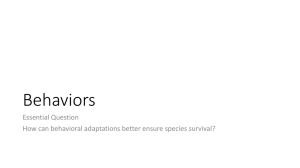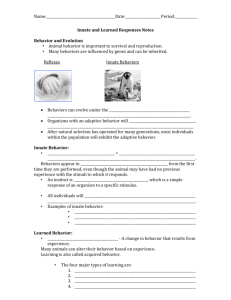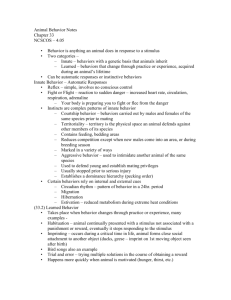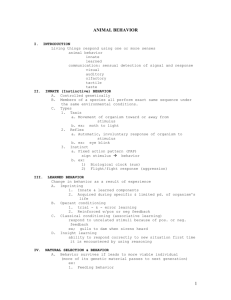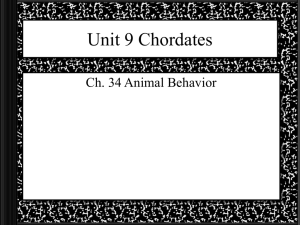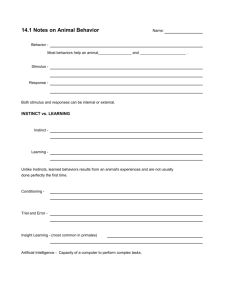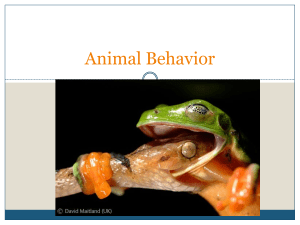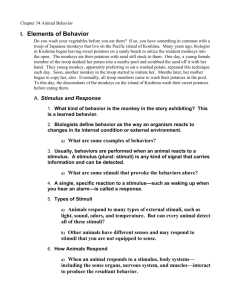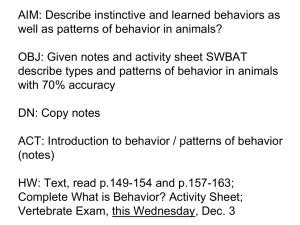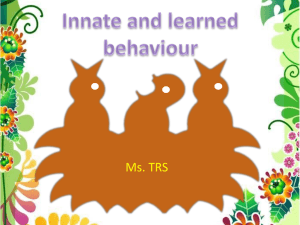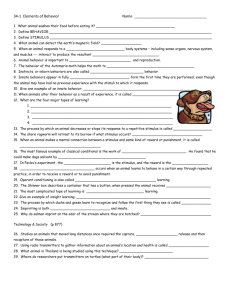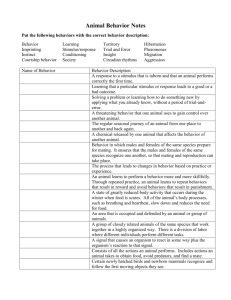I. Innate vs. Learned Behavior
advertisement
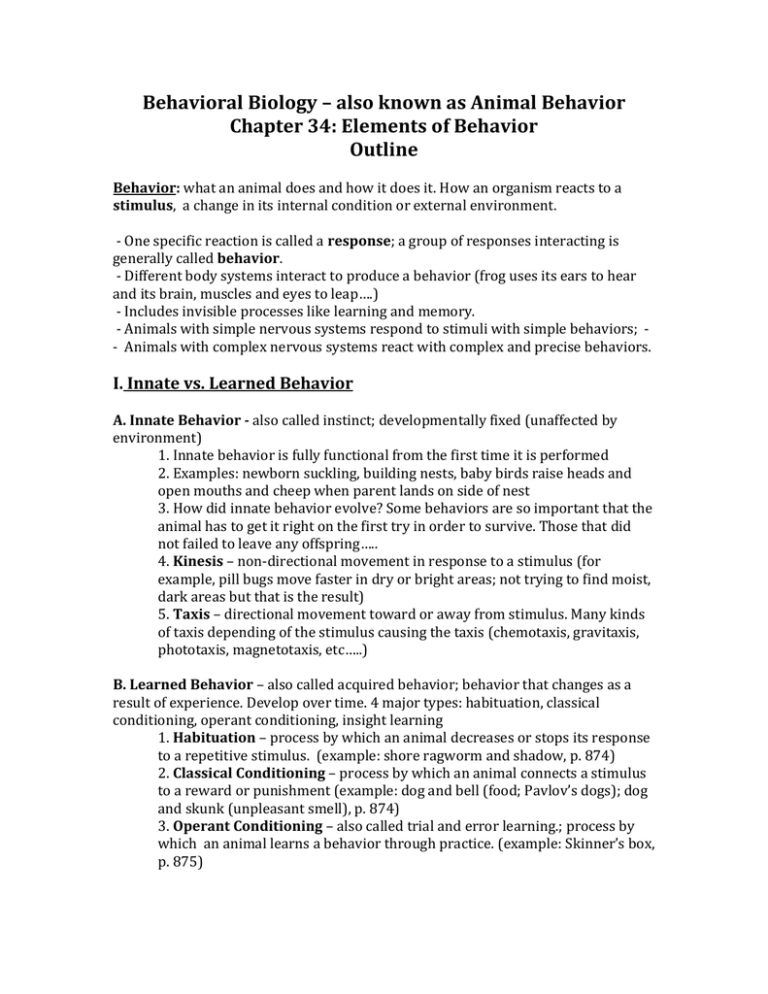
Behavioral Biology – also known as Animal Behavior Chapter 34: Elements of Behavior Outline Behavior: what an animal does and how it does it. How an organism reacts to a stimulus, a change in its internal condition or external environment. - One specific reaction is called a response; a group of responses interacting is generally called behavior. - Different body systems interact to produce a behavior (frog uses its ears to hear and its brain, muscles and eyes to leap….) - Includes invisible processes like learning and memory. - Animals with simple nervous systems respond to stimuli with simple behaviors; - Animals with complex nervous systems react with complex and precise behaviors. I. Innate vs. Learned Behavior A. Innate Behavior - also called instinct; developmentally fixed (unaffected by environment) 1. Innate behavior is fully functional from the first time it is performed 2. Examples: newborn suckling, building nests, baby birds raise heads and open mouths and cheep when parent lands on side of nest 3. How did innate behavior evolve? Some behaviors are so important that the animal has to get it right on the first try in order to survive. Those that did not failed to leave any offspring….. 4. Kinesis – non-directional movement in response to a stimulus (for example, pill bugs move faster in dry or bright areas; not trying to find moist, dark areas but that is the result) 5. Taxis – directional movement toward or away from stimulus. Many kinds of taxis depending of the stimulus causing the taxis (chemotaxis, gravitaxis, phototaxis, magnetotaxis, etc…..) B. Learned Behavior – also called acquired behavior; behavior that changes as a result of experience. Develop over time. 4 major types: habituation, classical conditioning, operant conditioning, insight learning 1. Habituation – process by which an animal decreases or stops its response to a repetitive stimulus. (example: shore ragworm and shadow, p. 874) 2. Classical Conditioning – process by which an animal connects a stimulus to a reward or punishment (example: dog and bell (food; Pavlov’s dogs); dog and skunk (unpleasant smell), p. 874) 3. Operant Conditioning – also called trial and error learning.; process by which an animal learns a behavior through practice. (example: Skinner’s box, p. 875) 4. Insight Learning – most complicated! Applying learning to a new situation. Common in humans and primates. Have to really think! C. Instinct and Learning Combined 1. Most behaviors are a result of both these behaviors. 2. Imprinting. Some baby animals instinctively follow the first moving object they see, usually their mother. It helps keep them close ot their mother and helps them find food. They are born with this instinct, but with no knowledge of what their mother will look like. For example, in the movie Fly Away Home the baby geese imprinted on an airplane… And baby salmon imprint on the odor of the stream in which they were born. They head out to sea and then years later use their sense of smell to navigate them back to their home stream to spawn (release their eggs or sperm into the water). II. Complex Behavior Patterns A. Behavior Cycles - cycles in behavior in response to cycles in environment. Circadian rhythm in response to day and night, migration cycles in response to seasons. B. Courtship – behavior related to reproduction and reproductive strategy. (intrasexual competition, intersexual choice, courtship rituals…) C. Social Behavior - animals that live in groups interact closely and often cooperate. Because they share a large proportion of each other’s genes, they often cooperate closely. a. Sometimes make sacrifices for the group or for one member of the group – this is called altruism. b. Primates form some of the most complex social groups. D. Competition – when 2 animals claim a limited resource, the result is competition. a. Territoriality is an example of this – territories contain resources such as food, water, nesting sites, shelter, and/or mates. E. Communication – the passing of information from one animal to another (or others) a. Visual Signals – using movement and color to communicate with another animal. (Cuttlefish changes color and patterning for many purposes – p. 881) b. Chemical Signals – Animals with a strong sense of smell communicate with chemicals. This includes many insects, fish and mammals. i. Pheromones are chemical messengers that affect behavior of other individuals in the same species. Use to mark territory and signal readiness to mate. c. Sound Signals – birdsong, cricket song, toad calls, dolphins, whales. d. Language – most complex form of communication. Only used by humans.
